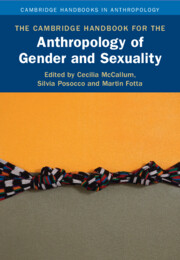Book contents
- The Cambridge Handbook for the Anthropology of Gender and Sexuality
- Cambridge Handbooks in Anthropology
- The Cambridge Handbook for the Anthropology of Gender and Sexuality
- Copyright page
- Contents
- Contributors
- 1 Introduction to The Cambridge Handbook for the Anthropology of Gender and Sexuality
- Part One Openings and Orientations
- Part Two Knowledges and Domains
- 6 Gender, Sociality, and the Person
- 7 The Postmodern Moment in Gender Studies and Anthropology
- 8 Gender(ed) Language and the Linguistics of Sexuality
- 9 Conceptualizing Bodies, Hierarchy, and Gendering across Cultures
- 10 Language, Gender and Sexuality, and Performativity
- 11 Anthropological Engagements with Men and Masculinities
- Part Three Resistances and Intersections
- Part Four Desires and Relations
- Part Five Recursivities and Futures
- Name Index
- Subject Index
- References
11 - Anthropological Engagements with Men and Masculinities
from Part Two - Knowledges and Domains
Published online by Cambridge University Press: 29 September 2023
- The Cambridge Handbook for the Anthropology of Gender and Sexuality
- Cambridge Handbooks in Anthropology
- The Cambridge Handbook for the Anthropology of Gender and Sexuality
- Copyright page
- Contents
- Contributors
- 1 Introduction to The Cambridge Handbook for the Anthropology of Gender and Sexuality
- Part One Openings and Orientations
- Part Two Knowledges and Domains
- 6 Gender, Sociality, and the Person
- 7 The Postmodern Moment in Gender Studies and Anthropology
- 8 Gender(ed) Language and the Linguistics of Sexuality
- 9 Conceptualizing Bodies, Hierarchy, and Gendering across Cultures
- 10 Language, Gender and Sexuality, and Performativity
- 11 Anthropological Engagements with Men and Masculinities
- Part Three Resistances and Intersections
- Part Four Desires and Relations
- Part Five Recursivities and Futures
- Name Index
- Subject Index
- References
Summary
This chapter charts historical developments and central themes in the anthropological study of men and masculinities. As the chapter shows, this body of knowledge is not free of frictions and contestations. Early anthropological studies were often motivated by finding globally generalizable patterns of masculinity. Other research has broadened the focus by questioning coherent gender-identities, analyzing how masculinity constructs are shaped by ambivalences, transgressive practices, and intersectional complexities. To chart this rich body of knowledge, the first part of the chapter critically discusses early anthropological research on men and masculinities as well as concepts that dominated the field for a considerable time. The remainder of the chapter focuses on three prominent topics of anthropological masculinity studies: economic crisis and its effect on masculinities, sexualities and nonnormative masculinities, and the role of masculinities in the negotiation of boundaries between others and selves. The chapter argues that anthropological engagements with masculinity can productively trouble our understanding of what it means to be a man.
Keywords
- Type
- Chapter
- Information
- Publisher: Cambridge University PressPrint publication year: 2023



